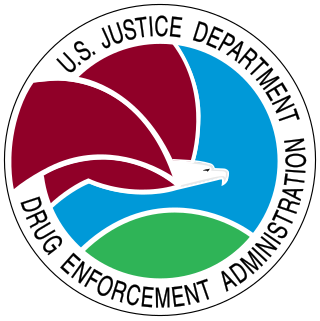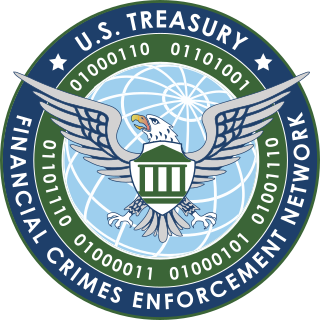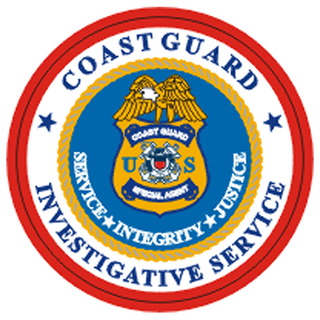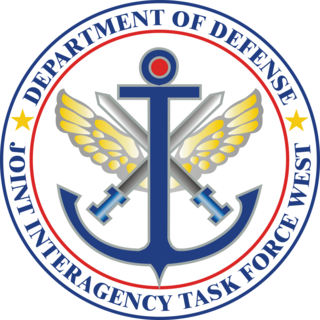
The Drug Enforcement Administration is a United States federal law enforcement agency under the U.S. Department of Justice tasked with combating illicit drug trafficking and distribution within the U.S. It is the lead agency for domestic enforcement of the Controlled Substances Act, sharing concurrent jurisdiction with the Federal Bureau of Investigation, the U.S. Immigration and Customs Enforcement, and U.S. Customs and Border Protection. However, the DEA has sole responsibility for coordinating and pursuing U.S. drug investigations both domestically and internationally.

The Financial Crimes Enforcement Network (FinCEN) is a bureau of the United States Department of the Treasury that collects and analyzes information about financial transactions in order to combat domestic and international money laundering, terrorist financing, and other financial crimes.

The United States attorney for the Northern District of California is responsible for representing the federal government in the United States District Court for the Northern District of California.

The Federal Law Enforcement Training Centers (FLETC) serves as an interagency law enforcement training body for 105 United States government federal law enforcement agencies. The stated mission of FLETC is to "...train those who protect our homeland". Through the Rural Policing Institute (RPI) and the Office of State and Local Training, it provides tuition-free and low-cost training to state, local, campus and tribal law enforcement agencies.

The Departament of Federal Police is a federal law enforcement agency of Brazil and one of the three national police forces. The other two are the Federal Highway Police, and the National Force. From 1944 to 1967 it was called the Federal Public Safety Department.

The Coast Guard Investigative Service (CGIS) is a division of the United States Coast Guard that investigates crimes where the U.S. Coast Guard has an interest. It is composed of civilian (GS-1811), active duty, reserve enlisted, and warrant officer special agents.

The Military Cooperation with Civilian Law Enforcement Agencies Act is a United States federal law enacted in 1981 that allows the United States Armed Forces to cooperate with domestic and foreign law enforcement agencies. Operations in support of law enforcement include assistance in counterdrug operations, assistance for civil disturbances, special security operations, counter-terrorism, explosive ordnance disposal (EOD), and similar activities. Constitutional and statutory restrictions and corresponding directives and regulations limit the type of support provided in this area. The legislation allows the U.S. military to give law enforcement agencies access to its military bases and its military equipment. The legislation was promoted during the Presidency of Ronald Reagan in the context of the War on drugs, and is considered a part of a general trend towards the militarization of police.

In Brazil, the Federal Constitution establishes eight law enforcement institutions - seven titulars and one auxiliar. The titular institutions are: the Federal Police, the Federal Highway Police, the Federal Railroad Police, the Federal Penal Police, the State Military Police and Fire Brigade, the State Civil Police and the State Penal Police. Of these, the first four are affiliated to federal authorities and the latter three are subordinated to state governments. These public safety institutions are part of the Executive branch of either federal or state government. Apart from these eight institutions, there are others which affiliate to municipal authorities: the Municipal Guards. According to Minister Alexandre de Moraes of the Supreme Federal Court, "...the Municipal Guards are inserted in public safety as the auxiliary and related body of public security force..." Federal law 13,022 gave them de facto and de jure police attributions.

Transnational organized crime (TOC) is organized crime coordinated across national borders, involving groups or markets of individuals working in more than one country to plan and execute illegal business ventures. In order to achieve their goals, these criminal groups use systematic violence and corruption. Common transnational organized crimes include conveying drugs, conveying arms, trafficking for sex, toxic waste disposal, materials theft and poaching.

Internal Revenue Service, Criminal Investigation (IRS-CI) is the United States federal law enforcement agency responsible for investigating potential criminal violations of the U.S. Internal Revenue Code and related financial crimes, such as money laundering, currency violations, tax-related identity theft fraud and terrorist financing that adversely affect tax administration. While other federal agencies also have investigative jurisdiction for money laundering and some Bank Secrecy Act violations, IRS-CI is the only federal agency that can investigate potential criminal violations of the Internal Revenue Code, in a manner intended to foster confidence in the tax system and deter violations of tax law. Criminal Investigation is a division of the Internal Revenue Service, which in turn is a bureau within the United States Department of the Treasury.
Operation Greenback was a Miami, Florida-based, multi-agency U.S. government task force targeting money laundering connected to drug trafficking.

In many countries, particularly those with a federal system of government, there may be several law enforcement agencies, police or police-like organizations, each serving different levels of government and enforcing different subsets of the applicable law.

The California Department of Justice is a statewide investigative law enforcement agency and legal department of the California executive branch under the elected leadership of the California Attorney General (AG) which carries out complex criminal and civil investigations, prosecutions, and other legal services throughout the US state of California. The department is equivalent to the State Bureau of Investigation in other states.
Project Gunrunner is a project of the U.S. Bureau of Alcohol, Tobacco, Firearms and Explosives (ATF) intended to stem the flow of firearms into Mexico, in an attempt to deprive the Mexican drug cartels of weapons.

Joint Interagency Task Force West is a standing United States military joint task force with the mission of combating drug-related transnational organized crime in the Indo-Asia-Pacific. JIATF West's area of responsibility (AOR) is that of United States Indo-Pacific Command (USINDOPACOM). JIATF West is one of two Joint Interagency Task Forces with a counter-narcotics mission. The other is Joint Interagency Task Force South. The task force is run as USPACOM's "executive agent" for counterdrug activities providing support to partner nation law enforcement. Approximately 100 active duty and reserve U.S. military forces; Department of Defense civilian employees; contractors; and U.S. and foreign law enforcement agency personnel are members of the task force.
Drug trafficking organizations are defined by the United States Department of Justice as, "complex organizations with highly defined command-and-control structures that produce, transport, and/or distribute large quantity "Law enforcement reporting indicates that Mexican DTOs maintain drug distribution networks, or supply drugs to distributors, in at least 230 U.S. cities." The use of weapons and fear are commonplace in trafficking which often lead to other crimes in the process. The structures of many of these organizations are of a para-military nature using armed combatants to protect their stock of illegal drugs from growth to delivery.

The Stop Exploitation Through Trafficking Act of 2013 (SETT) is a bill that would require each state, within three years, to have in effect legislation that: (1) treats a minor who has engaged or attempted to engage in a commercial sex act as a victim of a severe form of trafficking in persons, (2) discourages the charging or prosecution of such an individual for a prostitution or sex trafficking offense, and (3) encourages the diversion of such individual to child protection services.

Aviation Drug-Trafficking Control Act of 1984 is a United States Federal law amending the Federal Aviation Act of 1958. The statutory law authorized criminal penalties for the unlawful aerial transportation of controlled substances. The Act of Congress mandated the revocation of aircraft registrations and airman certificates by the Federal Aviation Administration whereas an aircraft aviator knowingly engages in the transit of illicitly used drugs. The Act established authority and a statute of limitations for the reissuance of airman certificates by the United States Secretary of Transportation.
Operation Blue Storm was a successful police investigation of an illegal marijuana smuggling ring operating in Arizona and Nebraska. During a lengthy investigation in 2012, police investigators uncovered links between the South Family Bloods street gang of Omaha, Nebraska, and the Sinaloa Cartel of northwestern Mexico, which was supplying South Family with illegal marijuana smuggled into and out of Arizona. The Nebraska investigation resulted in the indictment and conviction of 15 individuals, and the seizure of $60,000 in property, while the investigation in Arizona resulted in the indictment of 11 others, who, according to police, were directly linked to the Sinaloa Cartel. Police officials also announced that the illegal marijuana ring was responsible for smuggling 16,000 pounds of product into the United States, with a street value of approximately $7.75 million.
The Kentucky Marijuana Strike Force, also known as the Kentucky Governor's Marijuana Strike/Task Force, is a multi-agency law enforcement task force managed by the Office of the Governor of Kentucky and Kentucky State Police Marijuana Suppression Branch, and composed of local, state and federal agencies organized expressly to eradicate illegal cannabis cultivation and trafficking in Kentucky. The task force was established in 1990, to combat marijuana cultivation on public lands in Kentucky that ranks third in the United States, behind California and Tennessee. An estimated $1 billion worth of marijuana in seized in Kentucky annually.














